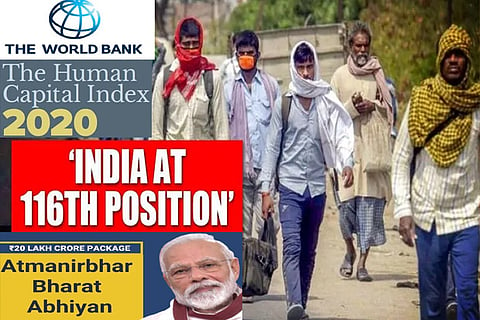

Chennai
The index benchmarks key components comprising human capital across countries, namely education and health, and the data pertains to the period up to March 2020, i.e. before the coronavirus pandemic had struck. A nation’s human capital is arrived at by adding up the potential future earnings of everyone in employment, and while India’s score has shown a marginal increase of 0.44 from 0.49, there’s a chance that future rankings may dip significantly, as the academic calendar of millions of students has been thrown out of gear. The report suggests that over a billion children globally have been out of school following the crisis, which could entail a loss of over $10 trillion in lifetime earnings. This is being considered as the fallout of reduced learning, school closures, and the
possibilities of dropping out of school. The pandemic has disproportionately affected women and girls as well.
While there are attempts being made to restart the learning process globally, there are systemic challenges endemic to the Indian landscape that makes this task harder. A case in point is the chasm dividing rural and urban India on digitisation. A report compiled on education by the National Sample Survey 2017-18 revealed that only 1 in every 4 Indian households have internet access. The disparity is stark if one considers most of the population lives in rural India – as much as 66 per cent, of which just about 15 per cent have internet access. In urban India, this figure stands at 42 per cent. There’s also the question of access to digital devices as it was pointed out that only 8% of households with children aged between 5 and 24 had access to both a PC and the internet.
Here in Tamil Nadu, the subject of e-learning has inspired impassioned debates between stakeholders in academia, politics, the students, and parent communities as well. While the TN govt was lauded for its TV-based e-learning solution via Kalvi TV, criticisms were levelled by residents in rural hilly regions in July, who argued that in the absence of interrupted power supply, and telecommunication networks comprising cable TV/DTH services, the process of e-learning was becoming daunting for children living in TN’s tribal hamlets. Parents also raised concerns of the readability of content displayed on TVs that were provided as part of the government’s welfare measures. There is also a need for a massive boost of infrastructure in regions that have been untouched by ‘state of the art’
technology. Recently, BSNL came to the rescue of citizens in north Chennai, by offering high-speed broadband facilities in areas that were considered commercially unviable by private operators.
Fulfilling the ideas envisioned in the Atmanirbhar Bharat Abhiyan requires the inclusivity of approach from both private and public enterprises. In the aftermath of the pandemic, and the promise of digitisation leading the way on the academic front, India must allocate an even greater quantum of the GDP, at least 6 per cent towards the education sector. Only then can India protect its human capital and ensure that the fallout of the pandemic will not impact the prospects of the next generation.
Visit news.dtnext.in to explore our interactive epaper!
Download the DT Next app for more exciting features!
Click here for iOS
Click here for Android